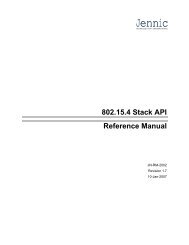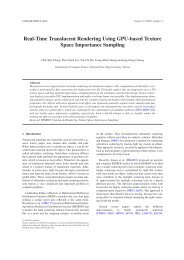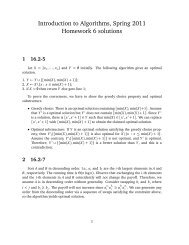Mirror MoCap: Automatic and efficient capture of dense 3D facial ...
Mirror MoCap: Automatic and efficient capture of dense 3D facial ...
Mirror MoCap: Automatic and efficient capture of dense 3D facial ...
You also want an ePaper? Increase the reach of your titles
YUMPU automatically turns print PDFs into web optimized ePapers that Google loves.
Visual Comput (2005)<br />
DOI 10.1007/s00371-005-0291-5 ORIGINAL ARTICLE<br />
I-Chen Lin (✉)<br />
Ming Ouhyoung<br />
<strong>Mirror</strong> <strong>MoCap</strong>: <strong>Automatic</strong> <strong>and</strong> <strong>efficient</strong><br />
<strong>capture</strong> <strong>of</strong> <strong>dense</strong> <strong>3D</strong> <strong>facial</strong> motion parameters<br />
from video<br />
Published online: 9 June 2005<br />
© Springer-Verlag 2005<br />
I-C. Lin<br />
Dept. <strong>of</strong> Computer <strong>and</strong> Information<br />
Science, National Chiao Tung University,<br />
1001 Ta Hsueh Road, Hsinchu, 300,<br />
Taiwan<br />
e-mail: ichenlin@cis.nctu.edu.tw<br />
M. Ouhyoung<br />
Dept. <strong>of</strong> Computer Science <strong>and</strong><br />
Information Engineering, National Taiwan<br />
University, No.1 Roosevelt Rd. Sec. 4,<br />
Taipei, 106, Taiwan<br />
e-mail: ming@csie.ntu.edu.tw<br />
Abstract In this paper, we present<br />
an automatic <strong>and</strong> <strong>efficient</strong> approach<br />
to the <strong>capture</strong> <strong>of</strong> <strong>dense</strong> <strong>facial</strong> motion<br />
parameters, which extends our previous<br />
work <strong>of</strong> <strong>3D</strong> reconstruction from<br />
mirror-reflected multiview video.<br />
To narrow search space <strong>and</strong> rapidly<br />
generate <strong>3D</strong> c<strong>and</strong>idate position lists,<br />
we apply mirrored-epipolar b<strong>and</strong>s.<br />
For automatic tracking, we utilize<br />
spatial proximity <strong>of</strong> <strong>facial</strong> surfaces<br />
<strong>and</strong> temporal coherence to find the<br />
best trajectories <strong>and</strong> rectify statuses<br />
<strong>of</strong> missing <strong>and</strong> false tracking.<br />
More than 300 markers on a subject’s<br />
face are tracked from video at a process<br />
speed <strong>of</strong> 9.2 frames per second<br />
(fps) on a regular PC. The estimated<br />
<strong>3D</strong> <strong>facial</strong> motion trajectories have<br />
been applied to our <strong>facial</strong> animation<br />
system <strong>and</strong> can be used for <strong>facial</strong><br />
motion analysis.<br />
Keywords Facial animation · Motion<br />
<strong>capture</strong> · Facial animation<br />
parameters · <strong>Automatic</strong> tracking<br />
1 Introduction<br />
From a big smile to a subtle frown to a pursed mouth,<br />
a face can perform various kinds <strong>of</strong> expressions to implicitly<br />
reveal one’s emotions <strong>and</strong> meanings. However, these<br />
frequent expressions, which we usually take for granted,<br />
involve highly complex internal kinematics <strong>and</strong> sophisticated<br />
variations in appearance. For example, during pronunciation,<br />
nonlinear transitions <strong>of</strong> a face surface depend<br />
on preceding <strong>and</strong> successive articulations, a phenomenon<br />
known as coarticulation effects [10].<br />
In order to comprehend the complicated variations<br />
<strong>of</strong> a face, recently more <strong>and</strong> more researchers have been<br />
using motion <strong>capture</strong> techniques that simultaneously<br />
record <strong>3D</strong> motion <strong>of</strong> a large number <strong>of</strong> sensors. When<br />
sensors are placed on a subject’s face, these techniques<br />
can extract the approximate motion <strong>of</strong> these designated<br />
points. Today, commercial motion <strong>capture</strong> devices, such<br />
as optical or optoelectronic systems, are able to accurately<br />
track dozens <strong>of</strong> sensors on a face. However, these devices<br />
are usually very expensive, <strong>and</strong> the expense becomes<br />
a significant barrier for researchers intending to devote<br />
themselves to areas related to <strong>facial</strong> analysis. Moreover,<br />
current motion <strong>capture</strong> devices are unable to track spatially<br />
<strong>dense</strong> <strong>facial</strong> sensors without interference. Not only<br />
can a large quantity <strong>of</strong> <strong>facial</strong> motion parameters directly<br />
provide more realistic surface deformation for <strong>facial</strong> animation,<br />
but the <strong>dense</strong> <strong>facial</strong> motion data could also be<br />
a key catalyst for further research. From the aspect <strong>of</strong> face<br />
synthesis, in the current process <strong>of</strong> animation production,<br />
<strong>facial</strong> motion <strong>capture</strong> data <strong>of</strong> 20 to 30 feature points are<br />
used to drive a well-prepared synthetic head. Motion vectors<br />
on the face’s uncovered areas are estimated by internal<br />
virtual muscles, scattering functions, or surface patches.<br />
Animators can only adjust co<strong>efficient</strong>s <strong>of</strong> the muscles or<br />
patches empirically from their observations. With <strong>dense</strong><br />
<strong>facial</strong> motion data as criteria, the co<strong>efficient</strong>s can be automatically<br />
calculated, <strong>and</strong> the results will be more faithful<br />
to real human <strong>facial</strong> expression. Regarding <strong>facial</strong> analysis,<br />
numerous hypotheses or models have been proposed<br />
to simulate <strong>facial</strong> motion <strong>and</strong> kinematics. Most current research<br />
uses only sparse <strong>facial</strong> feature points [18, 19] due to<br />
tracking device capacities. Sizeable <strong>and</strong> <strong>dense</strong> <strong>facial</strong> mo-
I-C. Lin, M. Ouhyoung<br />
tion trajectories can provide further detailed information<br />
for correlations <strong>of</strong> <strong>facial</strong> surface points in visual speech<br />
analysis.<br />
In our previous work [20], we proposed an accurate <strong>3D</strong><br />
reconstruction algorithm for mirror-reflected multiview<br />
images <strong>and</strong> a semiautomatic <strong>3D</strong> <strong>facial</strong> motion tracking<br />
procedure. Our previous system can track around 50 <strong>facial</strong><br />
markers using a single video camcorder with two mirrors<br />
under normal light conditions. When tracking <strong>dense</strong> <strong>facial</strong><br />
markers, we found that ambiguity in block matching<br />
caused the tracking to degenerate dramatically. Occlusion<br />
is the most critical problem: for example, when our<br />
mouths are pouting or opened wide, the markers below the<br />
lower lips vanish in video clips. We tried to use thresholding<br />
in block matching <strong>and</strong> Kalman predictors to tackle this<br />
problem; despite our efforts, it works satisfactorily only<br />
for short-term marker occlusion.<br />
Fully automatic tracking <strong>of</strong> multiple target trajectories<br />
over time is called the “multitarget tracking problem”<br />
in radar surveillance systems [8]. When only affected<br />
by measurement error <strong>and</strong> false detection, this<br />
problem is equivalent to the minimum cost network flow<br />
(MCNF) problem. The optimal solution is <strong>efficient</strong> [9, 27].<br />
Nevertheless, when measurement errors, missing detection<br />
(false negative), <strong>and</strong> false alarms (false positive) all<br />
occur during tracking, time-consuming dynamic programming<br />
is required to estimate approximate trajectories, <strong>and</strong><br />
the tracking results can degenerate seriously even if the<br />
occurrence frequency <strong>of</strong> missing detection slightly increases<br />
[28]. In our experiments, even though fluorescent<br />
markers <strong>and</strong> blacklight lamps are used to enhance the clarity<br />
<strong>of</strong> markers <strong>and</strong> to improve the steadiness <strong>of</strong> markers’<br />
projected colors, missing <strong>and</strong> false detections are still unavoidable<br />
in the feature extracting process.<br />
Fortunately, the motion <strong>of</strong> markers on a <strong>facial</strong> surface<br />
is unlike that <strong>of</strong> targets tracked in radar systems. Targets<br />
in the general multitarget-tracking problem move independently,<br />
<strong>and</strong> consequently the judgement <strong>of</strong> a target’s best<br />
trajectory can only st<strong>and</strong> on its prior trajectory. In contrast,<br />
points on a <strong>facial</strong> surface have not only temporal continuity<br />
but also spatial coherence. Except for the mouth,<br />
nostrils, <strong>and</strong> eyelids, a face is mostly a continuous surface,<br />
<strong>and</strong> a <strong>facial</strong> point’s positions <strong>and</strong> movements are similar<br />
to those <strong>of</strong> its neighbors. With this additional property, automatic<br />
diagnoses <strong>of</strong> missing <strong>and</strong> false detection become<br />
feasible <strong>and</strong> the computation is more <strong>efficient</strong>.<br />
Guenter et al. [14] tracked 182 dot markers painted<br />
with fluorescent pigments for near-UV light. This research<br />
used special markers <strong>and</strong> lights to enhance the feature detection,<br />
<strong>and</strong> the researchers took into account the spatial<br />
<strong>and</strong> temporal consistency for reliable tracking. Guenter<br />
<strong>and</strong> his colleagues’ impressive work inspired us.<br />
In this proposed work, we follow our previous framework<br />
<strong>of</strong> estimating <strong>3D</strong> positions from mirror-reflected<br />
multiview video clips [20] in which two mirrors are placed<br />
near a subject’s face <strong>and</strong> a single video camera is used<br />
to record simultaneously frontal <strong>and</strong> mirrored <strong>facial</strong> images.<br />
Instead <strong>of</strong> normal light conditions, to improve clarity,<br />
we also apply markers with UV-responsive pigments<br />
for blacklight blue (BLB) fluorescent lights. Compared to<br />
Guenter et al.’s work, the proposed method is more <strong>efficient</strong><br />
<strong>and</strong> versatile.<br />
Guenter et al.’s work required subjects’ heads to be<br />
immobile because <strong>of</strong> the limitation <strong>of</strong> markers’ vertical<br />
orders in their marker matching routine, <strong>and</strong> therefore<br />
head movement had to be tracked independently by other<br />
devices. In addition, there was no explicit definition <strong>of</strong><br />
tracking errors in this method, <strong>and</strong> an iterative approach<br />
was used for node matching. In contrast, our proposed<br />
method is capable <strong>of</strong> automatically tracking both <strong>facial</strong> expressions<br />
<strong>and</strong> head motions simultaneously without synchronization<br />
problems. Furthermore, we propose using<br />
mirrored epipolar b<strong>and</strong>s to rapidly generate <strong>3D</strong> c<strong>and</strong>idate<br />
points from projections <strong>of</strong> extracted markers <strong>and</strong> forming<br />
the tracking as a node-connection problem. Both spatial<br />
<strong>and</strong> temporal coherence <strong>of</strong> <strong>dense</strong> markers’ motion are applied<br />
to <strong>efficient</strong>ly detect <strong>and</strong> compensate missing tracking,<br />
false tracking, <strong>and</strong> tracking conflicts. Our system is<br />
now able to <strong>capture</strong> more than 300 markers at a process<br />
speed <strong>of</strong> 9.2 fps <strong>and</strong> can be extended for a regular PC to<br />
track more than 100 markers from live video in real time.<br />
This paper is organized as follows. In Sect. 2, we mention<br />
related research in <strong>facial</strong> motion <strong>capture</strong> <strong>and</strong> face<br />
synthesis. Section 3 describes equipment setting <strong>and</strong> gives<br />
an overview <strong>of</strong> our proposed tracking procedure. Section 4<br />
presents how to extract feature points from image sequences<br />
<strong>and</strong> explains the construction <strong>of</strong> <strong>3D</strong> c<strong>and</strong>idates. In<br />
Sect. 5, we present a procedure to find the best trajectories<br />
<strong>and</strong> to tackle the problem <strong>of</strong> missing <strong>and</strong> false tracking.<br />
The experimental results <strong>and</strong> discussion are presented in<br />
Sect. 6. Finally, we present our conclusions in Sect. 7.<br />
2 Related work<br />
For tracking to be fully automatic, some studies have employed<br />
a generic <strong>facial</strong> motion model. Goto et al. [13]<br />
used separate simple tracking rules for eyes, lips, <strong>and</strong><br />
other <strong>facial</strong> features. Pighin et al. [23, 24] proposed tracking<br />
animation-purposed <strong>facial</strong> motion based on linear<br />
combination <strong>of</strong> <strong>3D</strong> face model bases. Ahlberg [1] proposed<br />
a near-real-time face tracking system without markers<br />
or initialization. In “voice puppetry” [7], Br<strong>and</strong> applied<br />
a generic head mesh with 26 feature points, where<br />
spring tensions were assigned to each edge connection.<br />
Such a generic <strong>facial</strong> motion model can rectify “derailing”<br />
trajectories <strong>and</strong> is beneficial for sparse feature tracking;<br />
however, an approximate model can also overrestrict the<br />
feature tracking while a subject does exaggerated or unusual<br />
<strong>facial</strong> expressions.
<strong>Mirror</strong> <strong>MoCap</strong>: <strong>Automatic</strong> <strong>and</strong> <strong>efficient</strong> <strong>capture</strong> <strong>of</strong> <strong>dense</strong> <strong>3D</strong> <strong>facial</strong> motion parameters from video<br />
Fig. 1. Applying extracted motion parameters <strong>of</strong> 300 markers to a sythetic face. The first row is extracted <strong>3D</strong> motion vectors where the<br />
line segments represent displacement comparing to the neutral face; the middle row is a generic head driven by retargeting motion data;<br />
in the third row, the retargeting motion data are applied to a personalized face<br />
For <strong>3D</strong> <strong>facial</strong> motion tracking from multiple cameras,<br />
an optoelectronic system, e.g., Optotrak (www.ndigital<br />
.com/optotrak.html), uses optoelectronic cameras<br />
to track infrared-emitting photodiodes on a subject’s face.<br />
This kind <strong>of</strong> instrument is highly accurate <strong>and</strong> appropriate<br />
for analysis <strong>of</strong> <strong>facial</strong> biomechanics or coarticulation effects.<br />
However, each diode needs to be powered by wires,<br />
which may interfere with a subject’s <strong>facial</strong> motion.<br />
Applying passive markers can avoid this problem.<br />
In the computer graphics industry for movies or video<br />
games, animators usually make use <strong>of</strong> protruding spherical<br />
markers with high response to a special spectrum<br />
b<strong>and</strong>, e.g., red visible light or infrared in the vicon series<br />
(www.vicon.com). The high response <strong>and</strong> spherical<br />
shape make feature extraction <strong>and</strong> shape analysis easier,<br />
but these markers do not work well for lip surface<br />
motion tracking because people sometimes tuck in their<br />
lips, <strong>and</strong> these markers will obstruct the motion. Besides,<br />
the extracted motion <strong>of</strong> protruding markers is not the exact<br />
motion on a face surface but the motion at a small distance<br />
above the surface.<br />
In addition to capturing stereo videos with multiple<br />
cameras, Patterson et al. [22] proposed using mirrors<br />
to acquire multiple views for <strong>facial</strong> motion recording.<br />
They simplified the <strong>3D</strong> reconstruction problem <strong>and</strong> assumed<br />
mirrors <strong>and</strong> the camera were vertical. Basu et<br />
al. [3] employed a front view <strong>and</strong> a mirrored view to<br />
<strong>capture</strong> <strong>3D</strong> lip motion. In our previous work [20], we<br />
also applied mirrors for acquirement <strong>of</strong> <strong>facial</strong> images<br />
with different view directions. However, our <strong>3D</strong> reconstruction<br />
algorithm proved simpler yet more accurate<br />
because it conveniently uses symmetric properties <strong>of</strong> mir-
I-C. Lin, M. Ouhyoung<br />
rored objects. Readers can refer to [20] for a detailed<br />
explanation.<br />
Some devices <strong>and</strong> research apply other concepts to<br />
estimate <strong>3D</strong> motion or structure. Blanz et al. [6] used<br />
the optical flow method for correspondence recovery between<br />
scanned <strong>facial</strong> keyframes. Structured-light-based<br />
systems [11, 17, 29] project patterns onto a face <strong>and</strong> can<br />
therefore extract <strong>3D</strong> shape <strong>and</strong> texture. Detailed undulation<br />
on a face surface can be <strong>capture</strong>d with high-resolution<br />
cameras. Zhang et al.’s system [29] can even automatically<br />
track correspondences from consecutive depth images<br />
without markers by template matching <strong>and</strong> optical<br />
flow. However, the estimation can be unreliable for textureless<br />
regions.<br />
3 Overview<br />
3.1 Equipment setting<br />
In order to enhance the distinctness <strong>of</strong> markers from others<br />
in video clips, we utilize the fluorescent phenomenon<br />
covering markers with fluorescent pigments. When illuminated<br />
by BLB lamps, the pigments are excited <strong>and</strong><br />
emit fluorescence. Since the fluorescence belongs to visible<br />
light, no special attachment lens is required for the<br />
video camera. In our experiments, we found that fluorescent<br />
colors <strong>of</strong> our pigments could be roughly divided<br />
into four classes, green, blue, pink, <strong>and</strong> purple. To avoid<br />
ambiguity in the following tracking, we evenly place<br />
four classes <strong>of</strong> markers on a subject’s face <strong>and</strong> keep<br />
markers as far as possible from those <strong>of</strong> the same color<br />
class.<br />
The equipment setting <strong>of</strong> our tracking system is shown<br />
in Fig. 2. Two mirrors <strong>and</strong> two BLB lamps are placed in<br />
front <strong>of</strong> a digital video (DV) camcorder. The orientations<br />
<strong>and</strong> locations <strong>of</strong> mirrors can be arbitrary, as long as the<br />
front- <strong>and</strong> side-view images <strong>of</strong> a subject’s face are covered<br />
by the camera’s field <strong>of</strong> view (Fig. 3).<br />
After confirming the camera’s view field, including<br />
the frontal <strong>and</strong> two side views, the mirrors, the camera,<br />
<strong>and</strong> the intrinsic parameters <strong>of</strong> the camera have<br />
to be fixed. We use Bouguet’s camera calibration<br />
toolbox (www.vision.caltech.edu/bouguetj/<br />
calib_doc) based on Heikkila et al.’s work [16] to<br />
evaluate the intrinsic parameters (including focal lengths,<br />
distortion, etc.). The coordinate system is then normalized<br />
<strong>and</strong> undistorted based on the intrinsic parameters, called<br />
the normalized camera model. After this, we estimate the<br />
mirrors’ parameters by our previous work [20]. The normalized<br />
coordinate system is applied to all the following<br />
steps.<br />
Fig. 2. The tracking equipment. This photo is taken under normal light. Two “Blacklight Blue”(BLB) lamps are placed in front <strong>of</strong> a subject<br />
<strong>and</strong> mirrors. The low-cost special lamps are coated with fluorescent powders, <strong>and</strong> it can emit long wave UV-A radiation to excite<br />
luminescence
<strong>Mirror</strong> <strong>MoCap</strong>: <strong>Automatic</strong> <strong>and</strong> <strong>efficient</strong> <strong>capture</strong> <strong>of</strong> <strong>dense</strong> <strong>3D</strong> <strong>facial</strong> motion parameters from video<br />
Fig. 3. A <strong>capture</strong>d video clip <strong>of</strong> fluorescent markers illuminated only by BLB lamps. The fluorescence is visible in the visible light<br />
spectrum <strong>and</strong> no special lens is required for filtering<br />
3.2 Initialization<br />
Initialization <strong>of</strong> the tracking procedure reconstructs the<br />
<strong>3D</strong> positions <strong>of</strong> markers in the first frame (the neutral<br />
face). To <strong>efficient</strong>ly recover point correspondences in the<br />
first frame, two approaches can be used for different<br />
conditions.<br />
The first approach is to employ <strong>3D</strong> range scanned<br />
data. Figure 4 shows the process <strong>of</strong> recovering point correspondences.<br />
Before applying <strong>3D</strong> scanned data, the coordinate<br />
system <strong>of</strong> the data must conform to the normalized<br />
camera model. First, markers’ projected positions are extracted<br />
(Fig. 4a), <strong>and</strong> then a user has to manually select n<br />
(n > 3) corresponding point pairs on the nose tip, eye corners,<br />
mouth corners, etc. in the first video clip to form a<br />
<strong>3D</strong> point set S a . After corresponding feature points in <strong>3D</strong><br />
scanned data, S b , are also designated, the affine transformation<br />
between <strong>3D</strong> scanned data <strong>and</strong> specified markers’ <strong>3D</strong><br />
structure can be evaluated by a least-squares solution proposed<br />
by Arun et al. [2].<br />
While we extend the vector −→ op i ,whereo is the camera’s<br />
lens center <strong>and</strong> p i the extracted projected position<br />
<strong>of</strong> marker i in the frontal view, the intersection <strong>of</strong> the<br />
line −→ op i <strong>and</strong> <strong>3D</strong> scanned data is regarded as the <strong>3D</strong> position<br />
<strong>of</strong> marker i, denoted as m i . The corresponding point<br />
p ′ i<br />
in a side view is then recovered by mirroring m i to<br />
Fig. 4. Recovering 2D point correspondences with <strong>3D</strong> scanned data <strong>and</strong> RBF interpolation
I-C. Lin, M. Ouhyoung<br />
the mirrored space <strong>and</strong> projecting the mirrored one, m ′ i ,<br />
back to the image plane. Due to perturbation <strong>of</strong> measurement<br />
noise, within a tolerant region the nearest point<br />
<strong>of</strong> the same color class is regarded as the corresponding<br />
point p ′ i .<br />
The other approach is to recover point correspondences<br />
by evaluating a subject’s <strong>3D</strong> face structure directly from<br />
rigid-body motion. If an object is rigid or not deformable,<br />
affine transformation (rotation R <strong>and</strong> translation t) resulting<br />
from motion is equivalent to the inversed affine<br />
transformation resulting from changes in the coordinate<br />
system. Therefore, reconstructing the <strong>3D</strong> structure from<br />
rigid-body motion is equivalent to reconstructing the <strong>3D</strong><br />
structure from multiple views [26]. A subject is required<br />
to retain his or her face in a neutral expression <strong>and</strong> slowly<br />
move his or her head in four directions: right-up, rightdown,<br />
left-up, <strong>and</strong> left-down. A preliminary <strong>3D</strong> structure<br />
<strong>of</strong> the face can be estimated from markers’ projected motion<br />
in the frontal view, <strong>and</strong> point correspondence can then<br />
be recovered.<br />
3.3 Overview <strong>of</strong> the tracking procedure<br />
Figure 5 is the flow chart <strong>of</strong> the proposed tracking procedure.<br />
As mentioned in the Sect. 3.1, in the first step, we have<br />
to evaluate the parameters <strong>of</strong> the video camera <strong>and</strong> two<br />
mirrors. Markers’ <strong>3D</strong> positions in the neutral face are then<br />
estimated by the methods introduced in Sect. 3.2.<br />
For each successive frame t (t = 2 ...T end ), feature<br />
extraction is first applied to extract markers’ projected<br />
positions in the frontal <strong>and</strong> mirrored views. From the projected<br />
2D positions in real-mirrored image pairs <strong>and</strong> mirror<br />
parameters, we can calculate a set <strong>of</strong> <strong>3D</strong> positions,<br />
which are the markers’ possible <strong>3D</strong> positions. We call<br />
these <strong>3D</strong> positions “potential <strong>3D</strong> c<strong>and</strong>idates” (Fig. 8).<br />
After this step, the tracking becomes a node-connection<br />
problem with the possibility <strong>of</strong> missing nodes.<br />
Since we allow a subject’s head to move naturally, we<br />
find that the head movement dominates the markers’ motion<br />
trajectories. To avoid head motion seriously affecting<br />
the tracking results, before the “node matching” the global<br />
Fig. 5. The flow chart <strong>of</strong> our automatic <strong>3D</strong> motion tracking procedure for <strong>dense</strong> UV-responsive markers
<strong>Mirror</strong> <strong>MoCap</strong>: <strong>Automatic</strong> <strong>and</strong> <strong>efficient</strong> <strong>capture</strong> <strong>of</strong> <strong>dense</strong> <strong>3D</strong> <strong>facial</strong> motion parameters from video<br />
head motion has to be estimated <strong>and</strong> removed from <strong>3D</strong><br />
c<strong>and</strong>idates. The head motion is estimated from a set <strong>of</strong><br />
special markers, <strong>and</strong> adaptive Kalman filters, which work<br />
according to previous head motion transition, are applied<br />
to improve the stability.<br />
After the head motion is removed from the <strong>3D</strong> c<strong>and</strong>idates,<br />
for each marker we take into account its previous<br />
trajectories <strong>and</strong> its neighbors’ motion distribution to<br />
judge whether there is a most appropriate c<strong>and</strong>idate or it is<br />
a missing-node situation. Once a marker belongs to a situation<br />
<strong>of</strong> missing node, false tracking, or tracking conflict,<br />
we apply the comprehensive information <strong>of</strong> spatial <strong>and</strong><br />
temporal coherence to estimate the actual motion. Again,<br />
for each marker an individual Kalman filter is applied to<br />
improve the tracking stability.<br />
Details <strong>of</strong> feature extraction <strong>and</strong> the generation <strong>of</strong> <strong>3D</strong><br />
c<strong>and</strong>idates are described in Sect. 4. The tracking issues<br />
about head motion estimation, finding <strong>3D</strong> point correspondences,<br />
<strong>and</strong> detection <strong>and</strong> rectification <strong>of</strong> tracking errors<br />
are then presented in Sect. 5.<br />
4 Constructing <strong>3D</strong> c<strong>and</strong>idates from video clips<br />
For efficiency <strong>of</strong> tracking, we first have to narrow the<br />
search space. This issue can be divided into two parts: extracting<br />
markers’ projected 2D positions <strong>and</strong> constructing<br />
potential <strong>3D</strong> c<strong>and</strong>idates.<br />
4.1 Extracting markers from video clips<br />
As shown in the video clip (Fig. 3), because we use<br />
UV-responsive pigments <strong>and</strong> BLB lamps, markers are<br />
conspicuous in video clips. Hence, the automatic feature<br />
extraction can be more reliable <strong>and</strong> more feasible<br />
than under normal light conditions. We mainly follow the<br />
methodology <strong>of</strong> connected component analysis in computer<br />
vision, which is composed <strong>of</strong> thresholding, connected<br />
component labeling, <strong>and</strong> region property measurement,<br />
but we also slightly modify the implementation for<br />
computational efficiency.<br />
Since the intensity <strong>of</strong> UV-responsive markers is much<br />
higher than that <strong>of</strong> other markers, to exclude pixels that<br />
have less probability <strong>of</strong> marker projection, the first stage<br />
is color thresholding. For efficiency, we skip the mathematical<br />
morphology operations used by many feature extraction<br />
systems. The thresholding works satisfactorily in<br />
most cases; the most troublesome case, interlaced scan<br />
lines, can be solved more <strong>efficient</strong>ly by merging nearby<br />
connected components.<br />
The second stage is color labeling. In our experiment,<br />
we collect six kinds <strong>of</strong> UV-responsive markers that<br />
are painted with pink, yellow, green, white, blue, <strong>and</strong><br />
purple pigments. However, when illuminated by BLB<br />
lamps, there are only four typical colors—pink, bluegreen,<br />
dark blue, <strong>and</strong> purple. Hence, we mainly categorize<br />
markers into four color classes <strong>and</strong> each color<br />
class comprises dozens <strong>of</strong> color samples. A selection tool<br />
is provided to select these color samples from training<br />
videos. To classify the color <strong>of</strong> a pixel in video clips, the<br />
nearest neighborhood method (1-NN) is applied. To reduce<br />
the classification error resulting from intensity variation,<br />
the matching operation works on a normalized color<br />
R<br />
space (nR, nG, nB), wherenR = √ , nG =<br />
(R 2 +G 2 +B 2 )<br />
G<br />
√<br />
(R 2 +G 2 +B 2 ) , nB =<br />
√<br />
B<br />
,<strong>and</strong>(R, G, B) is the<br />
(R 2 +G 2 +B 2 )<br />
original color value. In general, the more color samples<br />
in a color class, the more accurate the color classification<br />
<strong>of</strong> a pixel. For real-time or near-real-time applications,<br />
around four color samples in each color class are sufficient.<br />
Connected component labeling is the third stage<br />
in our feature extraction. It groups connected pixels<br />
with the same color label number as a component, <strong>and</strong><br />
we adopt 8-connected neighbors. In our case, a marker’s<br />
projection is smaller than a radius <strong>of</strong> five pixels,<br />
<strong>and</strong> thus the process <strong>of</strong> connected component labeling<br />
can be simplified much more than general connectedcomponent-labeling<br />
approaches. We modify the classical<br />
algorithm [15] as partial connected component labeling<br />
(PCCL). Unlike the classical algorithm, for each pixel<br />
(i, j) we take a one-pass process <strong>and</strong> check only its preceding<br />
neighbors, (i − 1, j − 1), (i, j − 1), (i + 1, j − 1),<br />
<strong>and</strong> (i − 1, j). Not all 8-connected components can be labeled<br />
as the same group by PCCL since we do not use<br />
a large equivalent class table for transiting label numbers<br />
as in the classical one. But the problem <strong>of</strong> inconsistent<br />
label numbers can easily be solved in our next<br />
stage.<br />
After the process <strong>of</strong> partial connected component labeling,<br />
there are still redundant connected components<br />
caused by interlaced fields <strong>of</strong> video, incomplete connected<br />
component labeling, or noise. The fourth stage is to refine<br />
the connected components to make extracted components<br />
as close as possible to the actual markers’ projection. Because<br />
markers are placed evenly on a face <strong>and</strong> the shortest<br />
distance between two markers <strong>of</strong> the same color class<br />
is longer than the diameter <strong>of</strong> a dot marker, nearby connected<br />
components should belong to the same marker.<br />
Therefore, the first two kinds <strong>of</strong> redundant connected components<br />
can be simply tackled by merging components<br />
with a distance less than the markers’ average diameter.<br />
For the redundant components caused by noise, we suppress<br />
them by removing connected components less than<br />
four pixels.<br />
4.2 Constructing <strong>3D</strong> c<strong>and</strong>idates by mirrored epipolar<br />
b<strong>and</strong>s<br />
If there are N f <strong>and</strong> N s feature points <strong>of</strong> a certain color<br />
class extracted in the frontal <strong>and</strong> side views respectively,
I-C. Lin, M. Ouhyoung<br />
each point corresponding pair can generate a <strong>3D</strong> c<strong>and</strong>idate,<br />
<strong>and</strong> therefore there are a total <strong>of</strong> N f N s <strong>3D</strong> c<strong>and</strong>idates<br />
<strong>of</strong> this color class. Guenter et al. [14] took all N f N s potential<br />
<strong>3D</strong> c<strong>and</strong>idates to track N mrk markers’ motion, where<br />
N mrk is the amount <strong>of</strong> actual markers, N mrk ≪ N f N s .<br />
However, in a two-view system, given a point p i in the<br />
first image, its corresponding point is constrained to lie on<br />
a line called the “epipolar line” <strong>of</strong> p i . With this constraint,<br />
one only has to search features along the epipolar line. The<br />
number <strong>of</strong> <strong>3D</strong> c<strong>and</strong>idates decreases substantially <strong>and</strong> the<br />
computation is much more <strong>efficient</strong>.<br />
We found that there is a similar constraint in our<br />
mirror-reflected multiview structure. Since a mirrored<br />
view can be regarded as a flipped view from a virtual<br />
camera, the constraint should also exist but be flipped.<br />
We call this mirrored constraint the “mirrored epipolar<br />
line.” We briefly introduce the concept <strong>of</strong> the mirrored<br />
epipolar line in Fig. 6. We assume that p is an<br />
extracted feature point, o the optic center, <strong>and</strong> p ′ the un-<br />
known corresponding point in the mirrored view. Since<br />
p is a projection, the actual marker’s <strong>3D</strong> position, m,<br />
must lie on the line l op . According to the mirror symmetry<br />
property, the mirrored marker’s <strong>3D</strong> position, m ′ ,<br />
must lie on l ′ op , which is a symmetric line <strong>of</strong> l op with respect<br />
to the mirror plane. When a finite-size mirror model<br />
is adopted, the projection <strong>of</strong> l ′ op is a line segment, <strong>and</strong><br />
we denote it as p ′ a p′ b . The corresponding point p′ must<br />
then lie on this mirrored epipolar line segment p ′ a p′ b ,or<br />
otherwise the marker m is not visible in the mirrored<br />
view.<br />
The mirrored epipolar line <strong>of</strong> a point p can easily<br />
be evaluated. In our previous work [20], we deduced an<br />
equation between point p, p ′ <strong>and</strong> a mirror’s normal u =<br />
[a, b, c] T :<br />
(p ′ ) T Up= 0, where U =<br />
[ 0 −c<br />
] b<br />
c 0 −a . (1)<br />
−b a 0<br />
After we exp<strong>and</strong> p <strong>and</strong> p ′ by their x, y, <strong>and</strong>z components,<br />
the equation becomes<br />
[ x<br />
′<br />
p y ′ p 1 ] [ ]<br />
−cy p + b<br />
cx p − a = 0 , (2)<br />
−bx p + ay p<br />
<strong>and</strong> the line<br />
(−cy p + b)x ′ p + (cx p − a)y ′ p + (−bx p + ay p ) = 0 (3)<br />
is the mirrored epipolar line <strong>of</strong> p.<br />
For noise tolerance capability during potential <strong>3D</strong> c<strong>and</strong>idate<br />
evaluation, we extend the line k pixels up <strong>and</strong> down<br />
(k = 1.5 in our case) to form a “mirrored epipolar b<strong>and</strong>”<br />
<strong>and</strong> search corresponding points <strong>of</strong> the same color class<br />
within the region between two constraint lines<br />
(−cy p + b)x ′ p + (cx p − a)y ′ p + (−bx p + ay p )<br />
+ (cx p − a)k = 0 (3a)<br />
<strong>and</strong><br />
(−cy p + b)x ′ p + (cx p − a)y ′ p + (−bx p + ay p )<br />
− (cx p − a)k = 0 .<br />
(3b)<br />
Fig. 6. A conceptual diagram <strong>of</strong> the mirrored epipolar line. p is an<br />
extracted feature in the frontal view <strong>and</strong> l op is the line across o <strong>and</strong><br />
p. l ′ op is the line symmetric to l op by the mirror plane. m a m b is<br />
the projection segment <strong>of</strong> l ′ op on the mirror plane. p′ a p′ b<br />
, the projection<br />
<strong>of</strong> m a m b on the image plane I, is the mirrored epipolar line<br />
segment <strong>of</strong> p<br />
Figure 7 shows an example <strong>of</strong> potential point corresponding<br />
pairs generated by the mirrored epipolar constraint;<br />
Fig. 8 shows the <strong>3D</strong> c<strong>and</strong>idates generated from the constrained<br />
point correspondences.<br />
With this step the following tracking procedure can focus<br />
mainly on the set <strong>of</strong> potential <strong>3D</strong> c<strong>and</strong>idates. However,<br />
because there is measurement noise in extracted connected<br />
components <strong>and</strong> some markers are even occluded, the <strong>3D</strong><br />
c<strong>and</strong>idates may not include all markers’ positions. Therefore,<br />
an error-tolerant procedure has to be used for automatic<br />
tracking.
<strong>Mirror</strong> <strong>MoCap</strong>: <strong>Automatic</strong> <strong>and</strong> <strong>efficient</strong> <strong>capture</strong> <strong>of</strong> <strong>dense</strong> <strong>3D</strong> <strong>facial</strong> motion parameters from video<br />
Fig. 7. C<strong>and</strong>idates <strong>of</strong> point corresponding pairs under mirrored epipolar constraints. For each extracted feature in the frontal view, each<br />
feature point <strong>of</strong> the same color that lies within its mirrored epipolar b<strong>and</strong> is regarded as a corresponding point<br />
Fig. 8. Potential <strong>3D</strong> c<strong>and</strong>idates generated under the mirrored epipolar constraint <strong>and</strong> the distance constraint. <strong>3D</strong> c<strong>and</strong>idates are first constructed<br />
from c<strong>and</strong>idates <strong>of</strong> point correspondences; those whose positions are out <strong>of</strong> a bounding box are removed from the list <strong>of</strong> potential<br />
c<strong>and</strong>idates<br />
5 Reliable tracking<br />
The <strong>3D</strong> motion trajectories <strong>of</strong> markers comprise both <strong>facial</strong><br />
motion <strong>and</strong> head motion. Because the moving range <strong>of</strong><br />
a head is larger than that <strong>of</strong> <strong>facial</strong> muscles, when a subject<br />
enacts <strong>facial</strong> expressions <strong>and</strong> moves his or her head at the<br />
same time, most <strong>of</strong> the markers’ motion results from head<br />
motion. This situation could result in the Kalman predictors<br />
<strong>and</strong> filters affected mainly by head motion. We adopt<br />
separate Kalman predictors/filters for head motion <strong>and</strong> <strong>facial</strong><br />
motion tracking, <strong>and</strong> we find that the detection <strong>and</strong><br />
rectification <strong>of</strong> tracking error are more reliable if head motion<br />
is removed in advance.<br />
5.1 Head movement estimation <strong>and</strong> removal<br />
We assume the head pose in the first frame (t = 1) is upright.<br />
We also define the head motion at time t as the affine<br />
transformation <strong>of</strong> the head pose at time t with respect to<br />
the head pose at t = 1. The relation can be represented as<br />
h(t) = R head (t) · h(1) + T head (t), (4)<br />
where h can be any point on a head irrelevant to <strong>facial</strong> motion,<br />
R head (t) is rotation, <strong>and</strong> T head (t) is translation. For<br />
automatic head movement tracking, seven specific markers<br />
are pasted on locations invariant to <strong>facial</strong> motion, such<br />
as a subject’s ears <strong>and</strong> the concave tip on the nose column.
I-C. Lin, M. Ouhyoung<br />
Adaptive Kalman filters are used to alleviate unevenness<br />
in trajectories resulting from measurement errors.<br />
R head (t) <strong>and</strong> T head (t) both have three degrees <strong>of</strong> freedom.<br />
T head (t) =[t x (t), t y (t), t z (t)] T . R head (t) is a 3×3matrix<br />
<strong>and</strong> can be parameterized in terms <strong>of</strong> (r x (t), r y (t),<strong>and</strong><br />
r z (t)) in radians. Through least-squares fitting methods<br />
comparing elements <strong>of</strong> Eq. 5, (r x (t), r y (t), <strong>and</strong>r z (t)) can<br />
be extracted from R head (t).<br />
R head = R z R y R x<br />
=<br />
=<br />
[ cos(rz )<br />
][ ][ ]<br />
− sin(r z ) 0 cos(rr ) 0 sin(r y ) 1 0 0<br />
sin(r z ) cos(r z ) 0 0 1 0 0 cos(r x ) − sin(r x )<br />
0 0 1 − sin(r y ) 0 cos(r r ) 0 sin(r x ) cos(r x )<br />
[ c(rz )c(r y ) −s(r z )c(r x ) + c(r z )s(r y )s(r x ) s(r z )s(r x ) + c(r z )s(r y )s(r x )<br />
s(r z )s(r y ) c(r z )c(r x ) + s(r z )s(r y )s(r x ) −c(r z )s(r x ) + s(r z )s(r y )s(r x )<br />
−s(r y ) c(r y )s(r x ) c(r y )c(r x )<br />
where R z , R y ,<strong>and</strong>R x are rotation matrices along the z-,<br />
y-, <strong>and</strong> x-axes; c() <strong>and</strong> s() are abbreviations <strong>of</strong> cos() <strong>and</strong><br />
sin(). Kalman filters are applied directly to these six parameters:<br />
[r x (t), r y (t), r z (t), t x (t), t y (t), t z (t)]. The process<br />
<strong>of</strong> head motion evaluation is as follows. We use r x (t +1|t)<br />
to represent the prediction <strong>of</strong> parameter r x at time t + 1<br />
based on previous data <strong>of</strong> r x (1) to r x (t); similarly for other<br />
parameters.<br />
Step 1. Designate specific markers s i (for i = 1 ...N smrk ,<br />
where N smrk is the amount <strong>of</strong> specific markers,<br />
N smrk = 7 in our case) for head motion tracking<br />
from the reconstructed <strong>3D</strong> markers <strong>of</strong> the neutral<br />
face (t = 1), <strong>and</strong> denote their positions as<br />
ms i (1). (Either a specific color is used for the special<br />
markers or users have to designate them in the<br />
first frame.)<br />
Step 2. Initialize parameters <strong>of</strong> adaptive Kalman filters<br />
<strong>and</strong> set r x (1) = r y (1) = r z (1) = 0, t x (1) = t y (1) =<br />
t z (1) = 0, <strong>and</strong> t = 1.<br />
Step 3. Predict the head motion parameters r x (t + 1|t),<br />
r y (t + 1|t), r z (t + 1|t), t x (t + 1|t), t y (t + 1|t), <strong>and</strong><br />
t z (t + 1|t) by Kalman predictors <strong>and</strong> then construct<br />
R head (t + 1|t) <strong>and</strong> T head (t + 1|t) by Eq. 5.<br />
Increase timestamp t = t + 1<br />
Step 4. Generate predicted positions <strong>of</strong> specific markers<br />
as<br />
]<br />
(5)<br />
ms i (t|t − 1) = R head (t|t − 1) × ms i (1)<br />
+ T head (t|t − 1) (6)<br />
<strong>and</strong> find ms i (t) by searching the nearest potential<br />
<strong>3D</strong> c<strong>and</strong>idates <strong>of</strong> the same color. The search is restricted<br />
within a distance d srch from ms i (t|t − 1).<br />
If no c<strong>and</strong>idate is found, set the marker as invalid<br />
at time t.<br />
Step 5. Detect tracking error: if estimated motions are abnormal<br />
when compared to other specific markers,<br />
then set the markers <strong>of</strong> odd estimation as invalid at<br />
time t.<br />
(The tracking error detection is presented in the<br />
next subsection; we skip the details here.)<br />
Step 6. Estimate the affine transformation (R msr <strong>and</strong><br />
T msr ) <strong>of</strong> valid specific markers between time t <strong>and</strong><br />
the first frame by the method proposed by Arun et<br />
al. [2].<br />
Step 7. Extract r msr_x (t), r msr_y (t), <strong>and</strong> r msr_z (t) from<br />
R msr by Eq. 5 <strong>and</strong> extract t msr_x (t), t msr_y (t), <strong>and</strong><br />
t msr_z (t) from T msr .<br />
Take the extracted parameters as measurement inputs<br />
to the adaptive Kalman filter <strong>and</strong> estimate the<br />
output [r x (t), r y (t), r z (t), t x (t), t y (t), t z (t)].<br />
Step 7. Ift > T limit , stop; else go to Step 3.<br />
We use a position-velocity configuration for the Kalman<br />
filters for translation, where <strong>3D</strong> positions are measurement<br />
input <strong>and</strong> the internal states are positions <strong>and</strong> velocities.<br />
The operation <strong>of</strong> the Kalman filters for rotation is similar,<br />
but the input is a set <strong>of</strong> angles <strong>and</strong> the internal states represent<br />
angles <strong>and</strong> angular velocities. Once the head motion<br />
at time t is evaluated, an inverse affine transformation is<br />
applied to all <strong>3D</strong> c<strong>and</strong>idates for head motion removal.<br />
5.2 Recovering frame-to-frame <strong>3D</strong> point correspondence<br />
with outlier detection<br />
In this subsection, we assume that head motion is removed<br />
from potential <strong>3D</strong> c<strong>and</strong>idates, <strong>and</strong> our goal is to<br />
track markers’ motion trajectories from a frame-by-frame<br />
sequence <strong>of</strong> potential <strong>3D</strong> c<strong>and</strong>idates. Figure 9 is a conceptual<br />
diagram <strong>of</strong> the problem statement. For clarity <strong>of</strong><br />
explanation, we take the situation <strong>of</strong> only one color class<br />
<strong>of</strong> markers as examples. The methodology <strong>of</strong> processing<br />
each color class independently can extend to cases <strong>of</strong> multiple<br />
color classes.<br />
The number <strong>of</strong> potential <strong>3D</strong> c<strong>and</strong>idates in a frame is<br />
around 1.2 ∼ 2.3 times the number <strong>of</strong> the actual markers.<br />
The additional <strong>3D</strong> c<strong>and</strong>idates can be regarded as false detection<br />
in the multitarget tracking problem. If only false<br />
detection occurs, the graph algorithms for minimum cost<br />
network flow (MCNF) can evaluate the optimal solution.<br />
In our case, we employ Kalman predictors <strong>and</strong> filters to<br />
<strong>efficient</strong>ly calculate the time-varying position variation <strong>of</strong><br />
each marker. However, a marker can “miss” in video clips<br />
occasionally. The missing condition results from blocking<br />
or occlusion due to camera views, incorrect classification<br />
<strong>of</strong> marker colors, or noise disturbance. When the missing<br />
<strong>and</strong> false detection occur concurrently, a simple tracking<br />
method without evaluation <strong>of</strong> tracking error would degenerate<br />
<strong>and</strong> the successive motion trajectories could be<br />
disordered.<br />
We use an example to explain the serious consequence<br />
<strong>of</strong> tracking errors. In Fig. 10, marker B is not included<br />
in the potential <strong>3D</strong> c<strong>and</strong>idates <strong>of</strong> the third frame, <strong>and</strong> its<br />
actual position is denoted as B(3). Based on the previous<br />
trajectory, B’(3) is the nearest potential c<strong>and</strong>idate with
<strong>Mirror</strong> <strong>MoCap</strong>: <strong>Automatic</strong> <strong>and</strong> <strong>efficient</strong> <strong>capture</strong> <strong>of</strong> <strong>dense</strong> <strong>3D</strong> <strong>facial</strong> motion parameters from video<br />
Fig. 9. A conceptual figure for the problem statement <strong>of</strong> <strong>3D</strong> marker tracking. The markers’ <strong>3D</strong> positions in the 1st frame are first evaluated.<br />
The goal <strong>of</strong> <strong>3D</strong> motion tracking is to find frame-to-frame <strong>3D</strong> point correspondences from sequences <strong>of</strong> potential <strong>3D</strong> c<strong>and</strong>idates<br />
Fig. 10. An example <strong>of</strong> tracking errors resulting from missing markers<br />
respect to the predicted position. According to this false<br />
trajectory B(1) → B(2) → B’(3), the next position should<br />
be B’(4). Consequently, the motion trajectory starts to “derail”<br />
seriously <strong>and</strong> is difficult to recover. Furthermore,<br />
false tracking <strong>of</strong> a marker may even interfere with tracking<br />
<strong>of</strong> other markers. In the example <strong>of</strong> Fig. 10, marker<br />
C is also undetected in the fourth frame; the nearest c<strong>and</strong>idates<br />
with respect to the predicted position is C’(4).<br />
Unfortunately, C’(4) is actually marker D at the fourth<br />
frame, denoted as D(4). Because each potential c<strong>and</strong>idate<br />
should be “occupied” by one marker at most, a misjudgment<br />
would not only make marker C but also marker D<br />
depart from the correct trajectories.<br />
For detection <strong>of</strong> tracking errors, we take advantage<br />
<strong>of</strong> the spatial coherence <strong>of</strong> face surfaces, which means<br />
a marker’s motion is similar to that <strong>of</strong> its neighbors. Before<br />
we present our method, the terms are specified in<br />
advance. For a marker i, its neighbors are other markers<br />
that locate within a <strong>3D</strong> distance ε from its position in the<br />
neutral face, m i (1). For the motion <strong>of</strong> marker i at time<br />
t, we do not use the <strong>3D</strong> location difference between time<br />
t − 1<strong>and</strong>t but instead use the location difference between<br />
time t <strong>and</strong> time 1. We denote v i (t) = m i (t) − m i (1); this<br />
is because the former is easily disturbed by measurement<br />
noise but the latter is less sensitive to noise. The motion<br />
similarity between marker i <strong>and</strong> marker j at time t<br />
is defined as the Euclidean distance between two motion<br />
vectors ‖v i (t) − v j (t)‖.<br />
A statistical approach is used to judge whether a marker’s<br />
motion at time t is a tracking error. For each marker i,<br />
we first calculate the similarity <strong>of</strong> each neighbor <strong>and</strong> sort<br />
them in decreasing order. To avoid contamination <strong>of</strong> the
I-C. Lin, M. Ouhyoung<br />
judgment by unknown tracking error <strong>of</strong> neighbors, only<br />
the first α% neighbors in order <strong>of</strong> similarity are included<br />
in the sample space Ω (α = 66.67 in our experiments).<br />
This mechanism can also solve the judgment problem on<br />
discontinuous parts (e.g., excluding motions on the upper<br />
lips from the reference neighbor sets <strong>of</strong> motions on the<br />
lower lips). We presume that the vectors within the sample<br />
space Ω approximate a Gaussian distribution. The averages<br />
<strong>and</strong> st<strong>and</strong>ard deviations <strong>of</strong> the x, y,<strong>and</strong>z components<br />
<strong>of</strong> v j (for all j ∈ Ω) are denoted as (µ vx ,µ vy ,µ vz ) <strong>and</strong><br />
(σ vx ,σ vy ,σ vz ), respectively. We define that a tracked motion<br />
v i (t) is valid if it is not far from the distribution <strong>of</strong><br />
most <strong>of</strong> its neighbors.<br />
The judgment criterion <strong>of</strong> valid or invalid tracking for<br />
the marker i is<br />
{ JF(i, t) threshold, valid tracking<br />
(7)<br />
else,<br />
invalid tracking<br />
<strong>and</strong> the judgment function is<br />
√<br />
JF(i, t) = Sx 2 + S2 y + S2 z , (8)<br />
where S x = x vi −µ vx<br />
σ vx +k , S y = y vi−µ vy<br />
σ vy +k , S z = x vi −µ vz<br />
σ vz +k , <strong>and</strong><br />
v i (t) = (x vi , y vi , z vi ).<br />
S x , S y ,<strong>and</strong>S z can be regarded as the divergence <strong>of</strong> v i<br />
with respect to the refined neighbors Ω in the x, y, <strong>and</strong><br />
z directions. If the difference between v i <strong>and</strong> the average<br />
<strong>of</strong> its neighbors is within the st<strong>and</strong>ard deviations, the<br />
values S are smaller than 1; on the other h<strong>and</strong>, if the divergences<br />
are larger, the values increase. In Eq. 8, k is a small<br />
user-defined number. With k in the denominators, we can<br />
prevent unpredictable values <strong>of</strong> S x , S y ,<strong>and</strong>S z when markers<br />
are close to their locations <strong>of</strong> the neutral face.<br />
After we eliminate the invalid tracking <strong>of</strong> <strong>3D</strong> c<strong>and</strong>idates,<br />
a conflicting situation can still exist. Two valid motions<br />
that do not share the same <strong>3D</strong> c<strong>and</strong>idates could have<br />
the same extracted 2D feature points in either the frontal<br />
view or the side view. We call this the tracking conflict.<br />
To prevent the tracking conflict, we simply evaluate the<br />
number <strong>of</strong> valid motions for each 2D feature point. If a 2D<br />
feature point is “occupied” by more than one valid motion,<br />
we only keep the motion closest to the prediction as a valid<br />
motion.<br />
5.3 Estimating positions <strong>of</strong> missing markers<br />
If an invalid tracking is detected, the similarity <strong>of</strong> its<br />
neighbors in motion can also be used to conjecture the<br />
position or motion <strong>of</strong> the missing marker. Based on this<br />
idea, two interpolation methods are applied to the estimation.<br />
The first one is the weighted combination method.<br />
For a missing marker i, the motion at time t can be estimated<br />
by a weighted combination <strong>of</strong> that <strong>of</strong> its neighbors<br />
<strong>and</strong> it can be presented by the equation:<br />
v i = ∑ j<br />
( )<br />
1<br />
v j , for j ∈ Neighbor(v i ), (9)<br />
d ij + kc<br />
where d ij is the distance between m i <strong>and</strong> m j in the neutral<br />
face <strong>and</strong> kc is a small constant to avoid a very large weight<br />
when the marker i <strong>and</strong> j are quite close in the neutral face.<br />
In addition, a radial-basis-function (RBF) based data<br />
scattering method is also appropriate for the position<br />
estimation <strong>of</strong> missing markers. The abovementioned<br />
weighted combination method tends to average <strong>and</strong><br />
smooth the motions <strong>of</strong> all the neighbors; in contrast, the<br />
Fig. 11. The rectified motion trajectories. We utilize the temporal coherence <strong>of</strong> a marker’s motion <strong>and</strong> the spatial coherence between<br />
neighbor markers to detect <strong>and</strong> rectify false tracking
<strong>Mirror</strong> <strong>MoCap</strong>: <strong>Automatic</strong> <strong>and</strong> <strong>efficient</strong> <strong>capture</strong> <strong>of</strong> <strong>dense</strong> <strong>3D</strong> <strong>facial</strong> motion parameters from video<br />
Fig. 12. The tracking results without vs. with tracking error rectification. The upper part is the result tracked without false tracking detection;<br />
the lower part is the result tracked with our rectification method. The snapshots from left to right are <strong>capture</strong>d at t = 20, 100, 300<br />
<strong>and</strong> 500<br />
influence <strong>of</strong> nearby neighbors can be greater in RBF<br />
interpolation in general (it depends on the radial basis<br />
function), <strong>and</strong>, therefore, more prominent motions can be<br />
estimated. Since the RBF interpolation is more time consuming,<br />
the weighted combination is adopted for real-time<br />
or near-real-time tracking. Figure 11 shows a conceptual<br />
diagram <strong>of</strong> rectifying false tracking; Fig. 12 shows the<br />
tracking results by a method with Kalman filtering only<br />
<strong>and</strong> by our method with rectification <strong>of</strong> tracking error.<br />
6 Experimental results <strong>and</strong> discussion<br />
Using the method proposed in this paper, we have successfully<br />
<strong>capture</strong>d a large amount <strong>of</strong> <strong>dense</strong> <strong>facial</strong> motion data<br />
from three subjects, including two males <strong>and</strong> one female.<br />
On one male subject’s face we placed 320 markers 3 mm<br />
in diameter; on the other two subjects’ faces we placed<br />
196 markers 4 mm in diameter <strong>and</strong> 7 special markers for<br />
head motion tracking. Due to view limitations <strong>and</strong> measurement<br />
errors, a small amount <strong>of</strong> markers are not visible<br />
in at least two views in half <strong>of</strong> the video sequence. Only<br />
300 markers are actually tracked in the former case, 179<br />
<strong>and</strong> 188 markers in the later ones.<br />
In our experiments, motion that we intended to <strong>capture</strong><br />
consists <strong>of</strong> three parts: coarticulations <strong>of</strong> visual speech<br />
(motion transition between phonemes), <strong>facial</strong> expressions,<br />
<strong>and</strong> natural speech. Regarding coarticulations, each <strong>of</strong> the<br />
subjects was required to pronounce 14 MPEG-4 basic<br />
phonemes, also called visemes. They are “none,” “p,” “f,”<br />
“T,” “t,” “k,” “tS,” “s,” “n,” “r,” “A:,” “e,” <strong>and</strong> “i.” Besides<br />
these, the subjects were also required to pronounce several<br />
vowel–consonant, vowel–vowel words, such as “tip,”<br />
“pop,” “void,” etc. Concerning <strong>facial</strong> expressions, subjects<br />
were required to perform 6 MPEG-4 <strong>facial</strong> expressions<br />
comprising “neutral,” “joy,” “sadness,” “anger,” “fear,”<br />
“disgust,” <strong>and</strong> “surprise.” Also, they had to perform several<br />
exaggerated expressions, e.g., mouth pursing, mouth<br />
twisting, cheek bulging, etc. Lastly, they were asked to<br />
speak about three different topics. Each <strong>of</strong> these talks was<br />
more than 1.5 min (2700 frames) <strong>and</strong> accompanied with<br />
vivid <strong>facial</strong> expressions. In the case without special markers<br />
for head motion estimation, the subjects’ head is fixed;<br />
in the other cases, subjects can freely <strong>and</strong> naturally nod or<br />
shake their heads while speaking.<br />
On a 3.0-GHz Pentium 4 PC, our system can automatically<br />
track motion trajectories <strong>of</strong> 300 markers at a speed <strong>of</strong><br />
9.2 fps. It can track 188 markers with head motion estimation<br />
at a speed <strong>of</strong> 12.75 fps.<br />
For analysis, we calculate the occurrence <strong>of</strong> tracking<br />
errors. As we mentioned in previous sections, we divide<br />
the tracking errors into three categories: missing nodes,<br />
false tracking, <strong>and</strong> tracking conflicts. Since our detection
I-C. Lin, M. Ouhyoung<br />
Fig. 13. Numbers <strong>of</strong> tracking errors detected in each frame <strong>of</strong> the same video sequence <strong>of</strong> Fig. 12<br />
Fig. 14. The number <strong>of</strong> accumulated tracking errors while no rectification is applied
<strong>Mirror</strong> <strong>MoCap</strong>: <strong>Automatic</strong> <strong>and</strong> <strong>efficient</strong> <strong>capture</strong> <strong>of</strong> <strong>dense</strong> <strong>3D</strong> <strong>facial</strong> motion parameters from video<br />
Fig. 15. Synthetic subtle <strong>facial</strong> expressions <strong>of</strong> joy, sadness, anger, fear, <strong>and</strong> disgust.<br />
Fig. 16. Synthetic <strong>facial</strong> expressions <strong>of</strong> pronouncing “a-i-u-e-o”<br />
<strong>and</strong> management processes for missing nodes <strong>and</strong> false<br />
tracking are the same, we merge them into a single state:<br />
false tracking. Occurrence <strong>of</strong> tracking errors usually results<br />
from abrupt <strong>facial</strong> motion <strong>and</strong> is quite divergent in<br />
different video sequences.<br />
For instance, we take a video sequence (Fig. 12) where<br />
a subject performed exaggerated <strong>facial</strong> expressions. As<br />
shown in Fig. 13, the average percentage <strong>of</strong> false tracking<br />
in each frame is about 7.45%, <strong>and</strong> the average percentage<br />
<strong>of</strong> tracking conflicts, which excluded the false tracking,<br />
is about 0.34%. The percentage is small, but if the tracking<br />
errors are not detected <strong>and</strong> rectified automatically, they<br />
can accumulate frame by frame <strong>and</strong> the tracking results<br />
can degenerate dramatically as time passes. The upper part<br />
<strong>of</strong> Fig. 12 shows the disaster <strong>of</strong> tracking without rectification.<br />
As shown in the lower part <strong>of</strong> Fig. 12, with our proposed<br />
method we can retain tracking stability <strong>and</strong> accuracy.<br />
The number <strong>of</strong> tracking errors that occur in the upper<br />
part <strong>of</strong> Fig. 12 is shown in Fig. 14. Without rectification,<br />
almost one third <strong>of</strong> markers fall within the tracking errors.<br />
The tracking results have also been applied to our realtime<br />
<strong>facial</strong> animation system [20]; the results are shown in<br />
Figs. 15–17. The static images may not manifest the time<br />
course reconstruction quality in tracking or motion retar-<br />
Table 1. The distribution <strong>of</strong> CPU usages in our system<br />
Operation<br />
CPU usage<br />
DV AVI file decoding 28.2%<br />
Image processing (labeling, connected components, etc.) 29.9%<br />
Calculating <strong>3D</strong> c<strong>and</strong>idates 18.0%<br />
Finding best trajectories 23.9%
I-C. Lin, M. Ouhyoung<br />
Fig. 17. Applying <strong>capture</strong>d <strong>facial</strong> expressions to others’ face models<br />
geting. Demo videos are available on our project Web site<br />
listed in the conclusion.<br />
As shown in Table 1, there is no obvious bottleneck<br />
stage <strong>of</strong> the CPU usage in our system. However, the operations<br />
in the stages <strong>of</strong> image processing <strong>and</strong> calculating<br />
<strong>3D</strong> c<strong>and</strong>idate points are mostly parallel, which can be further<br />
improved by SIMD (single instruction multiple data)<br />
or parallel computing.<br />
7 Conclusion <strong>and</strong> future work<br />
In this paper, we propose a new tracking procedure to automatically<br />
<strong>capture</strong> <strong>dense</strong> <strong>facial</strong> motion parameters from<br />
mirror-reflected multiview video, employing the property<br />
<strong>of</strong> mirror epipolar b<strong>and</strong>s to rapidly generate <strong>3D</strong> c<strong>and</strong>idates<br />
<strong>and</strong> effectively utilizing the spatial <strong>and</strong> temporal coherence<br />
<strong>of</strong> <strong>dense</strong> <strong>facial</strong> markers to detect <strong>and</strong> rectify tracking<br />
errors. Our system can <strong>efficient</strong>ly track such numerous<br />
motion trajectories in near real time. Moreover, our procedure<br />
is a general method <strong>and</strong> could also be applied to<br />
track motion <strong>of</strong> other continuous surfaces.<br />
All equipment used in the proposed system is <strong>of</strong>f the<br />
shelf <strong>and</strong> inexpensive. This system can significantly lower<br />
the entry barrier for research about analysis <strong>and</strong> synthesis<br />
<strong>of</strong> <strong>facial</strong> motion. Our demonstrations are now downloadable<br />
at our project website: http://www.cmlab.<br />
csie.ntu.edu.tw/∼ichen/MFAPExt/MFAPExt<br />
_Intro.htm. Besides the demonstrations, an executable<br />
s<strong>of</strong>tware package, user instructions, <strong>and</strong> examples are also<br />
on the Web site for users to download for their own research.<br />
Currently, the tracked motion parameters have been applied<br />
to our <strong>facial</strong> animation system. Dense <strong>facial</strong> motion<br />
data can be further used for refining co<strong>efficient</strong>s <strong>of</strong> existing<br />
<strong>facial</strong> motion models <strong>and</strong> even a criterion for face<br />
surface analysis. In our future work, we plan to analyze the<br />
correlations <strong>of</strong> <strong>facial</strong> surface points, for example, finding<br />
out which marker sets are the most representative.
<strong>Mirror</strong> <strong>MoCap</strong>: <strong>Automatic</strong> <strong>and</strong> <strong>efficient</strong> <strong>capture</strong> <strong>of</strong> <strong>dense</strong> <strong>3D</strong> <strong>facial</strong> motion parameters from video<br />
Table 2. The initial values <strong>of</strong> internal states’ parameters<br />
in adaptive Kalman filters. (1 frame =<br />
1/29.97 sec)<br />
State Variance <strong>of</strong> measurement noise Variance <strong>of</strong> velocity change<br />
x mi 1.69 mm 2 21.87 (mm/frame) 2<br />
y mi 1.69 mm 2 78.08 (mm/frame) 2<br />
z mi 3.31 mm 2 35.10 (mm/frame) 2<br />
r x 0.684 degree 2 43.77 (degree/frame) 2<br />
r y 0.858 degree 2 24.62 (degree/frame) 2<br />
r z 0.985 degree 2 2.736 (degree/frame) 2<br />
t x 1.00 mm 2 27.00 (mm/frame) 2<br />
t y 1.00 mm 2 27.00 (mm/frame) 2<br />
t z 1.56 mm 2 27.00 (mm/frame) 2<br />
8 Appendix<br />
We adapt a position-velocity configuration for the Kalman<br />
filters. Users can refer to [4] for the detailed state transition<br />
<strong>and</strong> system equations. The noise parameters are<br />
dynamically adaptable according to prediction errors.<br />
The inital values <strong>of</strong> the parameters <strong>of</strong> feature point<br />
m i = (x mi , y mi , z mi ), head rotation (r x , r y , r z ), <strong>and</strong> head<br />
translation (t x , t y , t z ) are defined empirically as listed<br />
in Table 2.<br />
Acknowledgement This work was partially supported by the National<br />
Science Council <strong>and</strong> the Ministry <strong>of</strong> Education <strong>of</strong> ROC under<br />
contract Nos. NSC92-2622-E-002-002, NSC92-2213-E-002-015,<br />
NSC92-2218-E-002-056, <strong>and</strong> 89E-FA06-2-4-8. We would like to<br />
acknowledge Jeng-Sheng Yeh, Pei-Hsuan Tu, Sheng-Yao Cho,<br />
Wan-Chi Luo, et al. for their assistance in the experiments. We<br />
would especially like to thank Dr. Michel Pitermann, whose face<br />
data we <strong>capture</strong>d for one <strong>of</strong> the models shown here. We would also<br />
like to thank Derek Tsai, a visiting student from the University <strong>of</strong><br />
Pennsylvania, who helped us improve the grammar <strong>and</strong> style <strong>of</strong> this<br />
paper.<br />
References<br />
1. Ahlberg J (2002) An active model for<br />
<strong>facial</strong> feature tracking. EURASIP J Appl<br />
Signal Process 6:566–571<br />
2. Arun KS, Huang TS, Blostein SD (1987)<br />
Least square fitting <strong>of</strong> two <strong>3D</strong> point sets.<br />
IEEE Trans Pattern Anal Mach Intell<br />
9(5):698–700<br />
3. Basu S, Pentl<strong>and</strong> A (1997)<br />
A three-dimensional model <strong>of</strong> human lip<br />
motions trained from video. In:<br />
Proceedings <strong>of</strong> the workshop on IEEE<br />
non-rigid <strong>and</strong> articulated motion, San Juan,<br />
Puerto Rico, pp 46–53<br />
4. Bozic SM (1979) Digital <strong>and</strong> Kalman<br />
filtering. Edward Arnold, London<br />
5. Blanz V, Vetter T (1999) A morphable<br />
model for the synthesis <strong>of</strong> <strong>3D</strong> faces. In:<br />
Proceedings <strong>of</strong> ACM SIGGRAPH’99,<br />
pp 353–360<br />
6. Blanz V, Basso C, Poggio T, Vetter T<br />
(2003) Reanimating faces in images <strong>and</strong><br />
video. Comput Graph Forum<br />
22(2):641–650<br />
7. Br<strong>and</strong> M (1999) Voice puppetry. In:<br />
Proceedings <strong>of</strong> SIGGRAPH’99, pp 21–28<br />
8. Buckley K, Vaddiraju A, Perry R (2000)<br />
A new pruning/merging algorithm for MHT<br />
multitarget tracking. In: Proceedings <strong>of</strong><br />
Radar-2000<br />
9. Castañon DA (1990) Efficient algorithms<br />
for finding the k best paths through<br />
a trellis. IEEE Trans Aerospace Elect Syst<br />
26(1):405–410<br />
10. Cohen MM, Massaro DW (1993) Modeling<br />
co-articulation in synthetic visual speech.<br />
In: Magnenat-Thalmann N, Thalmann D<br />
(eds) Models <strong>and</strong> techniques in computer<br />
animation. Springer, Berlin Heidelberg<br />
New York, pp 139–156<br />
11. Davis J, Nehab D, Ramamoorthi R,<br />
Rusinkiewicz S (2005) Spacetime stereo:<br />
a unifying framework for depth from<br />
triangulation. IEEE Trans Pattern Anal<br />
Mach Intell 27(1):296–302<br />
12. Ezzat T, Geiger G, Poggio T (2002)<br />
Trainable videorealistic speech animation.<br />
ACM Trans Graph 21(2):388–398 (also in<br />
Proceedings <strong>of</strong> SIGGRAPH’02)<br />
13. Goto T, Kshirsagar S,<br />
Magnenat-Thalmann N (2001) <strong>Automatic</strong><br />
face cloning <strong>and</strong> animation using real-time<br />
<strong>facial</strong> feature tracking <strong>and</strong> speech<br />
acquisition. IEEE Signal Process Mag<br />
18(2):17–25<br />
14. Guenter B, Grimm C, Wood D, Malvar H,<br />
Pighin F (1998) Making faces. In:<br />
Proceedings <strong>of</strong> ACM SIGGRAPH’98,<br />
pp 55–66<br />
15. Haralick RH, Shapiro LG (1992) Computer<br />
<strong>and</strong> robotic vision, vol 1. Addison-Wesley,<br />
Reading, MA<br />
16. Heikkilä J, Silvén O (1997) A four-step<br />
camera calibration procedure with implicit<br />
image correction. In: Proceedings <strong>of</strong> the<br />
IEEE conference on computer vision <strong>and</strong><br />
pattern recognition, San Juan, Puerto Rico,<br />
pp 1106–1112<br />
17. Kalberer GA, Gool LV (2001) Face<br />
animation based on observed <strong>3D</strong> speech<br />
dynamics. In: Proceedings <strong>of</strong> Computer<br />
Animation 2001, Seoul, Korea. IEEE Press,<br />
New York, pp 18–24<br />
18. Kuratate T, Yehia H, Vatikiotis-Bateson E<br />
(1998) Kinematics-based synthesis <strong>of</strong><br />
realistic talking faces. In: Proceedings <strong>of</strong><br />
Auditory-Visual Speech Processing,<br />
pp 185–190<br />
19. Kshirsagar S, Magnenat-Thalmann N<br />
(2003) Visyllable based speech animation.<br />
Comput Graph Forum 22(2):631–639<br />
20. Lin I-C, Yeh J-S, Ouhyoung M (2002)<br />
Extracting <strong>3D</strong> <strong>facial</strong> animation parameters<br />
from multiview video clips. IEEE Comput<br />
Graph Appl 22(6):72–80<br />
21. P<strong>and</strong>zic IS, Ostermann J, Millen D (1999)<br />
User evaluation: synthetic talking faces for<br />
interactive services. Visual Comput<br />
15:330–340<br />
22. Patterson EC, Litwinowicz PC, Greene N<br />
(1991) Facial animation by spatial<br />
mapping. In: Proceedings <strong>of</strong> Computer<br />
Animation ‘91. Springer, Berlin Heidelberg<br />
New York, pp 31–44<br />
23. Pighin F, Hecker J, Lischinski D, Szeliski<br />
R, Salesin DH (1998) Synthesizing realistic<br />
<strong>facial</strong> expressions from photographs. In:<br />
Proceedings <strong>of</strong> ACM SIGGRAPH ’98,<br />
pp 75–84<br />
24. Pighin F, Szeliski R, Salesin DH (1999)<br />
Resynthesizing <strong>facial</strong> animation through <strong>3D</strong><br />
model-based tracking. In: Proceedings <strong>of</strong><br />
the international conference on computer<br />
vison, 1:143–150<br />
25. Tu P-H, Lin I-C, Yeh J-S, Liang R-H,<br />
Ouhyoung M (2004) Surface detail
I-C. Lin, M. Ouhyoung<br />
capturing for realistic <strong>facial</strong> animation. J<br />
Comput Sci Technol 19(5):618–625<br />
26. Weng J, Huang TS, Ahuja N (1989)<br />
Motion <strong>and</strong> structure from two perspective<br />
views: algorithms, error analysis, <strong>and</strong> error<br />
estimation. IEEE Trans Pattern Anal Mach<br />
Intell 11(5):451–476<br />
27. Wolf JK (1989) Finding the best set <strong>of</strong> K<br />
paths through a trellis with application to<br />
multitarget tracking. IEEE Trans Aerospace<br />
Elect Syst 26(1):287–296<br />
28. Yeasin M, Polat E, Sharma R (2004)<br />
A mutiobject tracking framework for<br />
interactive mutimedia applications. IEEE<br />
Trans Multimedia 6(2):398–405<br />
29. Zhang L, Snavely N, Curless B, Seitz SM<br />
(2004) Spacetime faces: high resolution<br />
<strong>capture</strong> for modeling <strong>and</strong> animation. ACM<br />
Trans Graph 23(2):548–558 (also in<br />
Proceedings <strong>of</strong> SIGGRAPH’04)<br />
I-CHEN LIN is an assistant pr<strong>of</strong>essor in the Department<br />
<strong>of</strong> Computer <strong>and</strong> Information Science,<br />
National Chiao Tung University, Taiwan. His<br />
research interests include computer graphics<br />
<strong>and</strong> virtual reality, especially in <strong>facial</strong> animation,<br />
motion <strong>capture</strong>, <strong>and</strong> <strong>3D</strong> object modeling.<br />
He received a B.S. <strong>and</strong> a Ph.D. in computer<br />
science from National Taiwan University in<br />
1998 <strong>and</strong> 2003, respectively. He is a member <strong>of</strong><br />
ACM SIGGRAPH, IEEE, <strong>and</strong> IEEE Computer<br />
Society.<br />
MING OUHYOUNG is a pr<strong>of</strong>essor in the Graduate<br />
Institute <strong>of</strong> Networking <strong>and</strong> Multimedia<br />
<strong>and</strong> in the Department <strong>of</strong> Computer Science<br />
<strong>and</strong> Information Engineering, National Taiwan<br />
University. His research interests include computer<br />
graphics, virtual reality <strong>and</strong> multimedia<br />
systems. He received a B.S. <strong>and</strong> an M.S. in<br />
electrical engineering from National Taiwan<br />
University <strong>and</strong> a Ph.D. from the University <strong>of</strong><br />
North Carolina at Chapel Hill. He is a member<br />
<strong>of</strong> IEEE <strong>and</strong> ACM.



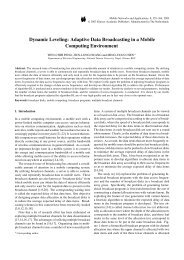
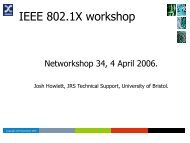

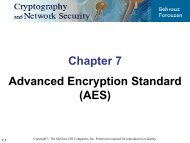
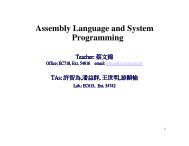
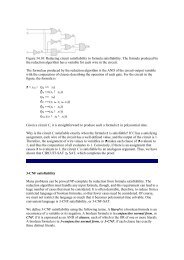
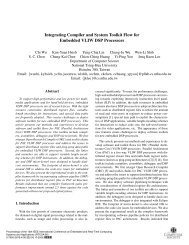
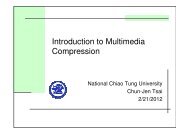

![Microsoft PowerPoint - 05_FTP.ppt [\254\333\256e\274\322\246\241]](https://img.yumpu.com/36298340/1/190x143/microsoft-powerpoint-05-ftpppt-254333256e274322246241.jpg?quality=85)
